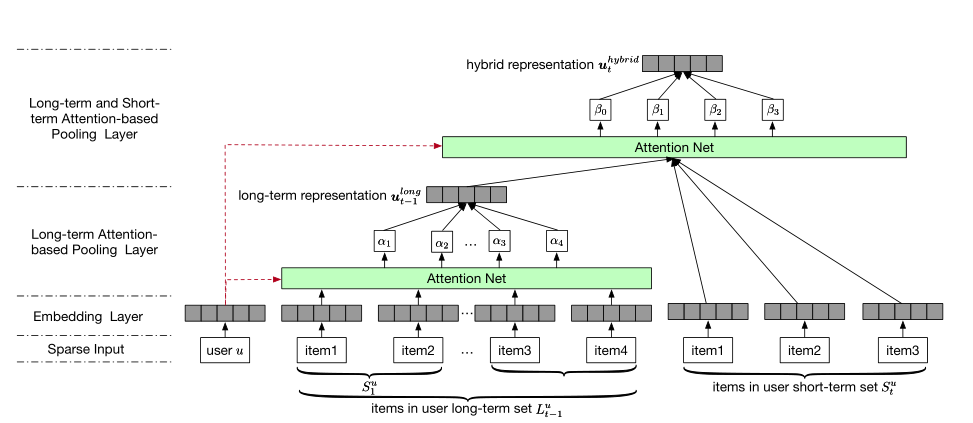SHAN¶
Introduction¶
Title: SHAN: Sequential Recommender System based on Hierarchical Attention Network.
Authors: Ying, H
Abstract: With a large amount of user activity data accumulated, it is crucial to exploit user sequential behavior for sequential recommendations. Conventionally, user general taste and recent demand are combined to promote recommendation performances. However, existing methods often neglect that user long-term preference keep evolving over time, and building a static representation for user general taste may not adequately reflect the dynamic characters. Moreover, they integrate user-item or item-item interactions through a linear way which limits the capability of model. To this end, in this paper, we propose a novel two-layer hierarchical attention network, which takes the above properties into account, to recommend the next item user might be interested. Specifically, the first attention layer learns user long-term preferences based on the historical purchased item representation, while the second one outputs final user representation through coupling user long-term and short-term preferences. The experimental study demonstrates the superiority of our method compared with other state-of-the-art ones.

Running with RecBole¶
Model Hyper-Parameters:
embedding_size (int): The embedding size of users and items. Defaults to64.short_item_length (int): The last N items . Defaults to2.reg_weight (float): The L2 regularization weight. Defaults to[0.01,0.0001].loss_type (str): The type of loss function. If it set to'CE', the training task is regarded as a multi-classification task and the target item is the ground truth. In this way, negative sampling is not needed. If it set to'BPR', the training task will be optimized in the pair-wise way, which maximize the difference between positive item and negative item. In this way, negative sampling is necessary, such as setting--neg_sampling="{'uniform': 1}". Defaults to'CE'. Range in['BPR', 'CE'].
A Running Example:
Write the following code to a python file, such as run.py
from recbole.quick_start import run_recbole
parameter_dict = {
'neg_sampling': None,
}
run_recbole(model='SHAN', dataset='ml-100k', config_dict=parameter_dict)
And then:
python run.py
Notes:
By setting
reproducibility=False, the training speed of SHAN can be greatly accelerated.
Tuning Hyper Parameters¶
If you want to use HyperTuning to tune hyper parameters of this model, you can copy the following settings and name it as hyper.test.
learning_rate choice [0.001]
embedding_size choice [64]
short_item_length choice [1,2,4,8]
reg_weight choice ['[0.0,0.0]','[0.01,0.0001]']
Note that we just provide these hyper parameter ranges for reference only, and we can not guarantee that they are the optimal range of this model.
Then, with the source code of RecBole (you can download it from GitHub), you can run the run_hyper.py to tuning:
python run_hyper.py --model=[model_name] --dataset=[dataset_name] --config_files=[config_files_path] --params_file=hyper.test
For more details about Parameter Tuning, refer to Parameter Tuning.
If you want to change parameters, dataset or evaluation settings, take a look at